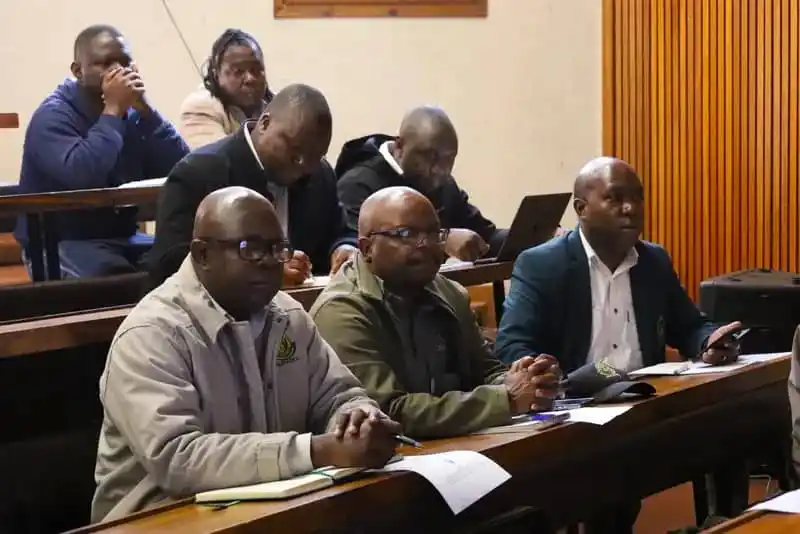
Climate Newsroom
June 19, 2025 at 04:22 PM
Bringing missing communities voices into the conservation conversation
The involvement of local communities in local and international conservation talks is essential, as decisions made at global forums often have a direct impact on the lives of people living near protected areas.
This emerged during a high-level stakeholder engagement convened in Harare recently, ahead of the 20th Conference of the Parties (CoP20) to the Convention on International Trade in Endangered Species of Wild Fauna and Flora (CITES), scheduled for November in Samarkand, Uzbekistan.
Zimbabwe Parks and Wildlife Management Authority (ZimParks) Director-General, Prof Edson Gandiwa, urged stakeholders to acknowledge the absence of local communities who live alongside wildlife but are often excluded from high-level conservation forums.
He gave a powerful analogy of the “empty chair” to highlight the absence of local communities in key conservation discussions. These are the people who live alongside wildlife and are most affected by policy decisions, yet their voices are often missing from the room.
“But more importantly, let us also remember the ’empty chair’. The empty chair represents those communities, those people who live with or alongside wildlife but cannot be here.
“As we present our cases and share our ideas, let us always remember that what we do here serves as a pivot for many who are not present,” he said.
In a strong call for inclusivity and leaving no one behind, Prof Gandiwa highlighted the role of youth, women, and local communities in environmental protection efforts.
Broadening their participation is not only key to making conservation effective and rooted in local stewardship, but also supports broader sustainable development goals.
“We also want to acknowledge the critical role of inclusivity in our conservation efforts. The engagement of youth, women, and local communities is essential, not only to broaden participation but also to ensure that conservation remains a cornerstone of local stewardship and sustainable development.”
Community involvement in wildlife dialogues is often limited, despite being crucial for successful conservation efforts. While some initiatives exist to integrate local communities into wildlife management, challenges remain in ensuring effective and inclusive participation.
Midlands State University School of Social Work Executive Director, Dr Noel Muridzo (MSU) says Zimbabwe and like-minded countries are right to call for the inclusion of communities in policy discussions, as those most affected should have a voice.
He believes inclusion fosters a sense of ownership and encourages shifts in harmful belief systems that have contributed to resource depletion, ultimately promoting stronger environmental stewardship.
“Zimbabwe and other like minded countries are correct to advocate for the inclusion of communities in the discussions. Communities are affected by decisions made. So it is only logical to include them. Again, for sustainability and efficacy of decisions and agreements there needs to be buy-in and ownership of processes.”
“Inclusions will translate to ownership, change in belief systems some of which have been the reasons behind depletion of the finite resources. Also, inclusion results in greater stewardship,” he said.
ZimParks spokesperson, Tinashe Farawo said communities living alongside wildlife are often the first line of defence in conservation, yet they remain underappreciated.
“Communities are the first line of defence in wildlife areas. We have armies who provide a security service to countries, and they are paid to do so. So why cannot communities derive benefits or incentives as they protect and defend their countries’ wildlife stock?
He added that local voices must be heard at international forums, such as the upcoming CITES COP20, where decisions can directly affect their livelihoods.
“Community voices need to be heard at international forums as decisions that are made at these forums have a direct impact on their livelihoods. As we prepare for this CITES COP20 that is on the agenda to have indigenous people and communities involved at international forums.’
There is also a growing call to prioritise investment in regions where wildlife populations are stable or increasing, as these strongholds are vital for the long-term survival of species across the continent.
“Prioritising investment in the protection of those population strongholds that are stable or increasing is vital because of their importance for the long-term viability and survival of the species across the continent,” he said.
Zimbabwe is working with rural district councils through the Communal Areas Management Programme for Indigenous Resources (CAMPFIRE), which enables local communities to generate income from safari hunting, photographic tourism and natural resource use.
Initially, about 60% of international hunting revenues were allocated to communities, but this has recently increased to 100%, allowing them greater control over the funds.
The revenue is invested in communal infrastructure such as schools, clinics and boreholes, with some funds distributed directly to households, often through budgets approved by the community.
“We have functional CAMPFIRE programmes in areas such as Hwange RDC, Tsholotsho, Chipinge, Bikita, and many others. The idea is to ensure that these communities benefit, or at the very least, view the animals as an economic opportunity. If someone sees an elephant, they must see a job, they must see development. These are some of the initiatives we are working on with the communities,” Farawo said.
Several African countries have achieved notable success by involving communities in wildlife management. In Namibia, the Communal Conservancy Programme has empowered local communities to manage wildlife and benefit from tourism and sustainable hunting, leading to wildlife recovery and improved livelihoods. Kenya’s community conservancies, particularly in the north, have helped reduce poaching, increase wildlife populations, and create jobs through tourism. Botswana’s CBNRM programme has supported community trusts that manage resources and benefit from eco-tourism and regulated hunting, although it faced setbacks during a national hunting ban.
Meanwhile, Tanzania’s Wildlife Management Areas (WMAs) allow villages to manage wildlife and earn revenue from tourism, contributing to conservation and local development. These models demonstrate that when communities are given rights and incentives, they can become effective stewards of wildlife.

❤️
👍
2